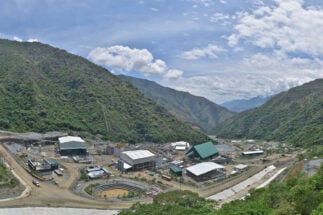Colombia’s coal industry is experiencing one of the worst crises in its recent history. The Covid-19 pandemic has compounded problems including labour strikes, criticism of its environmental and human rights standards, and a decline in sales to its traditional customers, which began at least five years ago.
In the midst of the gradual loss of European markets as they transition towards clean energy, coal companies have looked to China – the country’s second largest trading partner and a coal importer – as a possible destination for part of their future production.
However, any hopes China will save the day seems a remote possibility.
Colombia’s coal crisis
September 2020 began with a strike at El Cerrejón, the country’s largest coal mine, after labour negotiations collapsed between its operator Carbones del Cerrejón and Sintracarbón, the workers’ union. Almost at the same time, BHP Billiton, one of three companies along with Glencore and Anglo American that own the mine in equal shares, announced that it would sell its 33.3% stake.
A few weeks later, David Boyd, the UN’s special rapporteur on Human Rights, called on Colombia to halt production at the mine until there were safeguards in place to protect the social and environmental rights of the surrounding indigenous communities.
“I call on Colombia to implement the guidelines of its Constitutional Court and to do more to protect the vulnerable Wayúu community in the Provincial indigenous reserve against contamination from the El Cerrejón mine and against Covid-19,” he said.
These labour and social crises have coincided with a progressive reduction in international demand for coal and a loss of markets for Colombia, the world’s twelfth largest producer. For years, coal has been the country’s second largest export and an important source of national income.
However, figures for reveal a downward trend. “In terms of volumes, we think Colombia’s coal exports will fall to at least 58 million tonnes in 2020, compared to 74 million tonnes in 2019. And they could fall further if there is a long strike at El Cerrejón,” said Guillaume Perret, director of London-based market analysis consultancy Perret Associates.
This fall in exports has been accompanied by a fall in prices and production. Largely because of the pandemic, the country’s production fell by 7% in the first quarter of 2020 compared to the previous year and by 48.8% in the second quarter. Likewise, Colombian coal averaged US$38 per tonne between March and June 2020, and has fallen further to $33 – the lowest price since 2004, Claudia Bejarano, president of El Cerrejón, told economic daily La República.
We are going to have a serious problem with financial flows and employment generation in producing areas in about ten years
Three large coal companies in the country has felt the impact: Cerrejón, Drummond and Prodeco. “The mine that Glencore has in Colombia, through the company Prodeco, which it owns, has not been operating since March 23 […]. Prodeco has asked not to produce coal from its mines for four years, but the Colombian mining authorities have refused to give this authorisation,” Perret said.
Meanwhile, the price of gold has risen by 14% in the second quarter of 2020. Anticipating a shift in focus towards a more profitable product, Diego Mesa, minister of mines and energy, said in an interview with Reuters on October 2, that the future of Colombian mining was in metals: “The great opportunity for Colombia is in metal minerals because they are in the greatest demand at this time and in the future.”
Mesa’s statement statement sent shokewaves through Colombia’s coal industry. Silvana Habib, a consultant on mining issues and a fromer president of the National Mining Agency, said; “when you talk about Colombia as a mining country, you are talking about a coal-producing country.
“Right now we need all sectors to help improve accounts and have more resources. In my opinion, there is no other economic activity at the moment that can replace what coal generates, not only in terms of royalties and employment, but also in terms of social investment,” Habib added.
Coal accounts for 77% of Colombia’s mining exports and 18% of its total exports. This year, its GDP could contract by 7.8%, according to the International Monetary Fund, and unemployment rose to 16.8% in August because of the pandemic. The stakes are high.
US and European markets dwindle
Covid-19 represents the latest in a number of challenges for Colombia’s coal industry, which faces a black future as global demand centres shift amid countries’ structural energy transformations.
The main market for Colombian coal has traditionally been Europe, which between 2011 and 2013 accounted for 50% of exports. However, the market has since collapsed as some of its main clients, such as the Netherlands and Germany, implemented energy transition policies, switching from thermal electricity sources to clean technologies. Today the EU buys only 10% of Colombia’s coal exports.
“The two major poles of Colombian coal, which are Europe and the US, have experienced a very rapid fall in demand for coal in recent years,” says Paola Yanguas, research associate at the Coal Exit research centre.
“In the EU the main reason for the fall has been climate policy. In the US, it’s competition from other energy sources, such as shale gas [obtained by fracking] and renewable energies, mainly solar and wind power.
This situation highlights Colombia’s lack of planning. For the past five years, the country has had to start looking for new clients. But rather than targeting specific markets, the policies of the last two governments have focused on supporting production or infrastructure.
“Government policies are not focused on a particular market but on improving the sector’s competitiveness so that it can access increasingly distant and competitive markets such as Asia,” says Juan Camilo Nariño, president of the Colombian Mining Association. “We are working with the Government to promote a policy that will enable it to be increasingly competitive.”
The government of President Ivan Duque, however, has not outlined a concrete plan of action.
“I don’t think the government has sat down and looked at the details,” says Giovanni Pabón, a researcher into carbon and a former coordinator of the Environment Ministry’s Climate Change Mitigation Group. “We are going to have a serious problem with financial flows and employment generation in producing areas in about ten years or so”.
Coal companies, meanwhile, seem less inclined to talk publicly about the future of the business. At Carbones del Cerrejón, the largest company in the sector, the press office did not respond to our four interview requests since August, although their official mails returned automatic responses explaining that they were on strike.
Drummond, the second largest national producer and a private US company operating two mines in Cesar department, eventually responded, declining the offer to contribute to this article after a month of consultations with their parent company. And Prodeco, the third largest coal company in Colombia, claimed that they could answer our questions, but that they would refer them to their parent company, Glencore, in Switzerland. As of the date of publication, they had not responded. Fenalcarbón, the coal producers’ trade association, said it had no spokespersons available.
China, the promised market?
China is seen as a form of commercial promised land, an evaluation often based on wishful thinking reather than reality. Valora Analitik, an economist, however, has said that the world’s largest coal consumer could throw a lifeline to Colombian coal.
At the end of the day, it is still a colossal market. China imported 299.7 million tonnes of coal in 2019. Despite the Covid-19 crisis, its imports between January and April 2020 increased by 26.9% on the previous year to reach 126.73 million tonnes, according to statistics from the SteelGuru Strategic Research Institute.
For a few months in 2020 there was the illusion of a fast gateway to China. A diplomatic conflict between Australia and China, caused by Canberra’s call for an international enquiry into the Covid-19 pandemic, led to a temporary halt in Australian coal imports. The opportunity seemed huge – Australia is the world’s fourth largest producer.
The pandemic also led to a fall in sea freight volumes, and with it a fall in prices, facilitating access to the Asian market. Freight costs, which are normally between US$20 and $25 per tonne between Puerto Bolivar in the Colombian Caribbean and south-east China, fell $12.25 in April and $10.80 in May, according to figures from Perret Associates.
1%
China's share of Colombia's total coal exports
This window of opportunity, however, closed when the cost of freight rose again. In July it reached $27.25 per tonne. Several experts agree that the cost of transport means China is an unliekly major market for Colombian coal. Although it grew in the first half of 2020, China still accounts for scarcely 1% of Colombia’s coal exports.
“When freight prices rise, Colombia is at a disadvantage because it competes with Australian, Indonesian and Russian coal,” says Guillaume Perret. “Colombian coal is a volatile supplier to the east. When freight rates are low and demand is strong, it can be exported, but when costs rise, it is not competitive”.
Chinese President Xi Jinping dealt a further blow to Colombia’s coal ambitions when he announced at the UN in September that China aims to peak its greenhouse gas emissions by 2030 and achieve carbon neutrality by 2060. Like Europe, China is advancing its own energy transition.
The future of Colombian coal
While Colombia’s environmental commitments under the Paris Agreement are not linked to its coal production, changes in international demand do depend on the climate objectives of its customers. Greenhouse gas emissions that cause climate change count only for the country that burns fuels like coal, but not for those that produces and sell it, like Colombia.
Instead of China, Turkey and other emerging economies could save Colombian coal, according to observers. The huge increase in Colombian coal exports to Asia is due to the fact that Turkey is considered part of the continent. Between 2005 and 2015 sales increased by almost 400%. In 2019, Colombia exported US$1.1 billion worth of coal, representing 94.7% of its exports to the country, according to figures from the Ministry of Trade, Industry and Tourism.
There is one problem. When Turkey and other emerging economies upon which Colombian coal depends, such as Brazil and Panama, get serious about their energy transitions, this potential lifeline would disappear.
“It’s not so much a question of finding new markets,” says Giovanni Pabón, who stresses that there are structural problems the national coal industry might not recover from. “It is bad news at an economic level, but it is good news for our creativity in transforming coal jobs into renewable energies,” he adds.
As it rapidly loses one of its main sources of export revenues, Colombia may have no choice but to adapt or perish.









